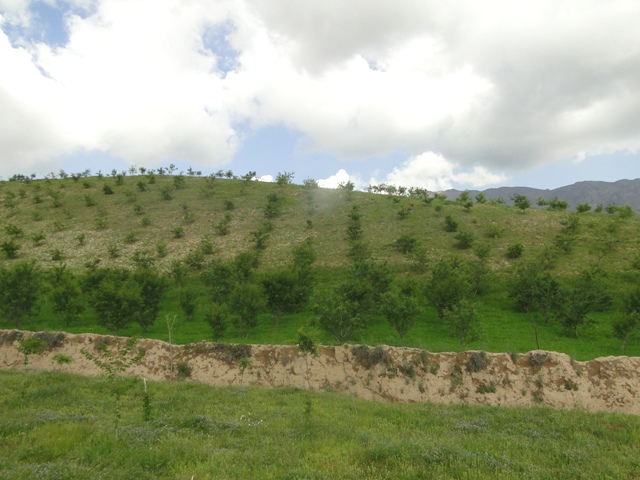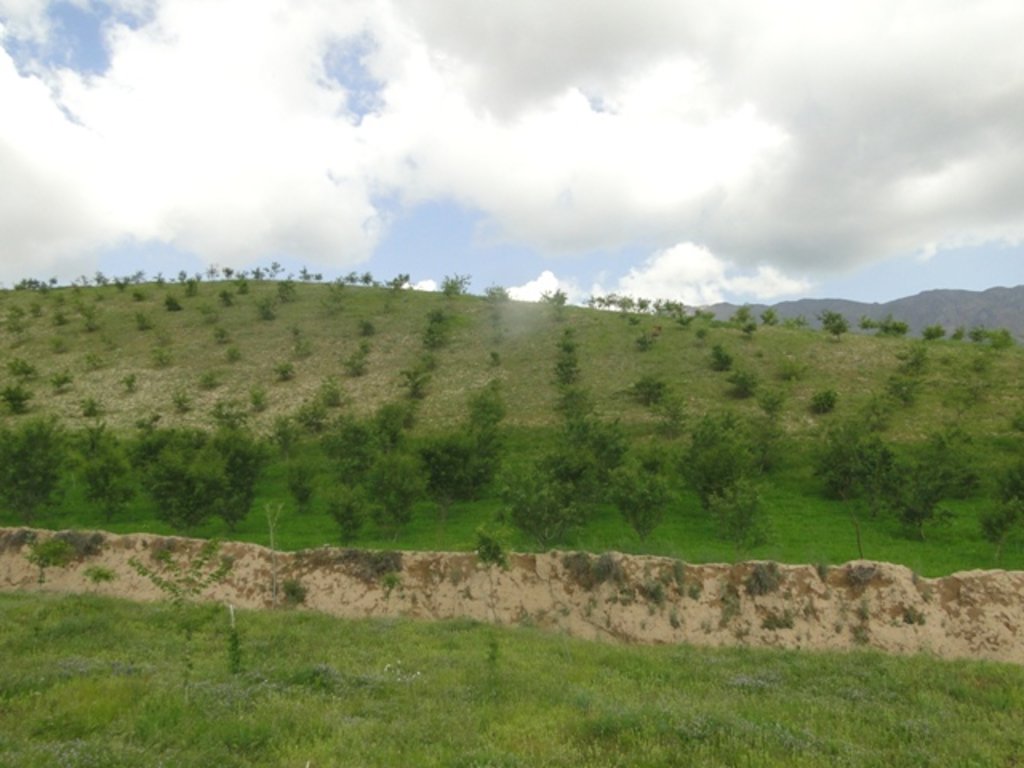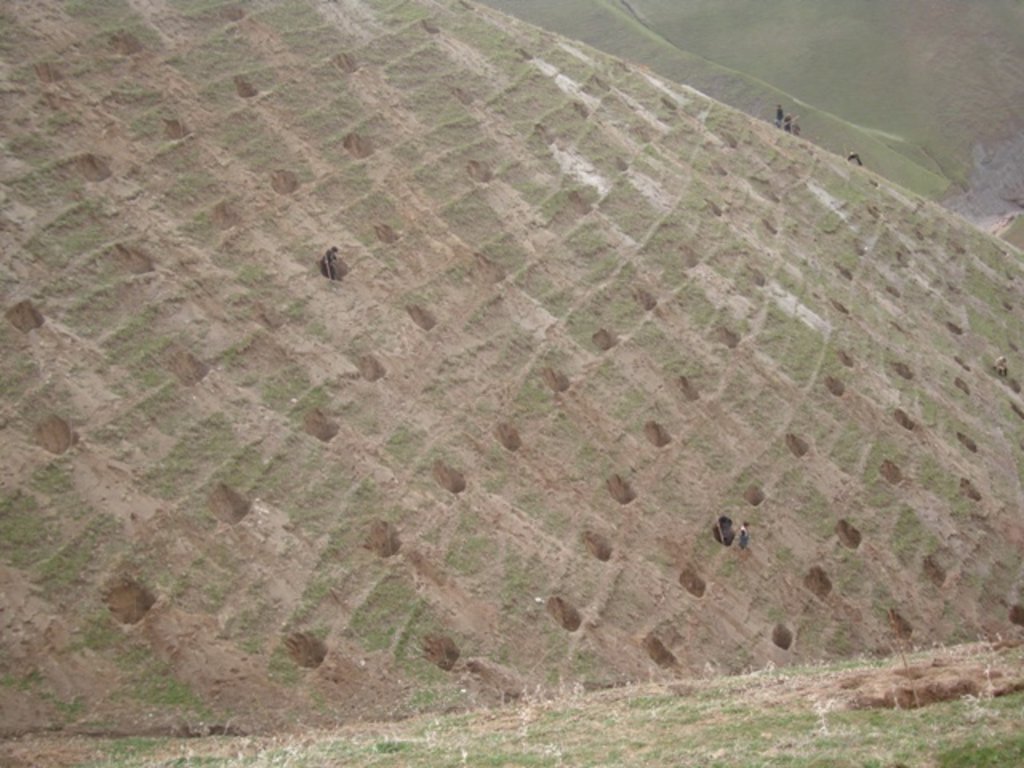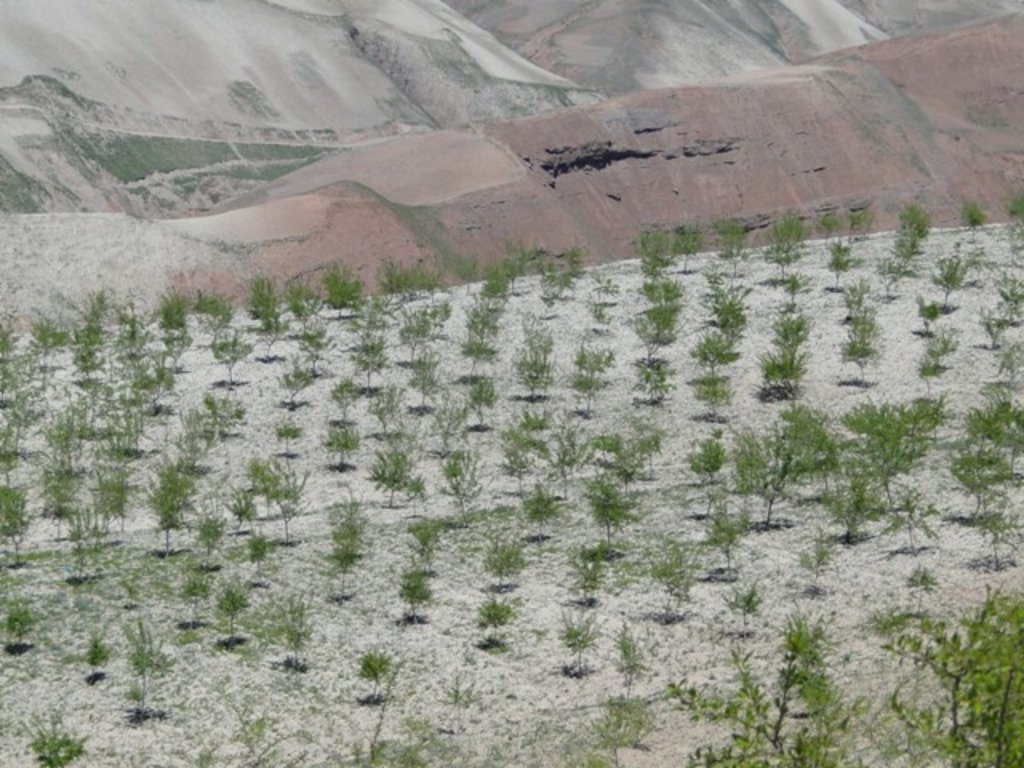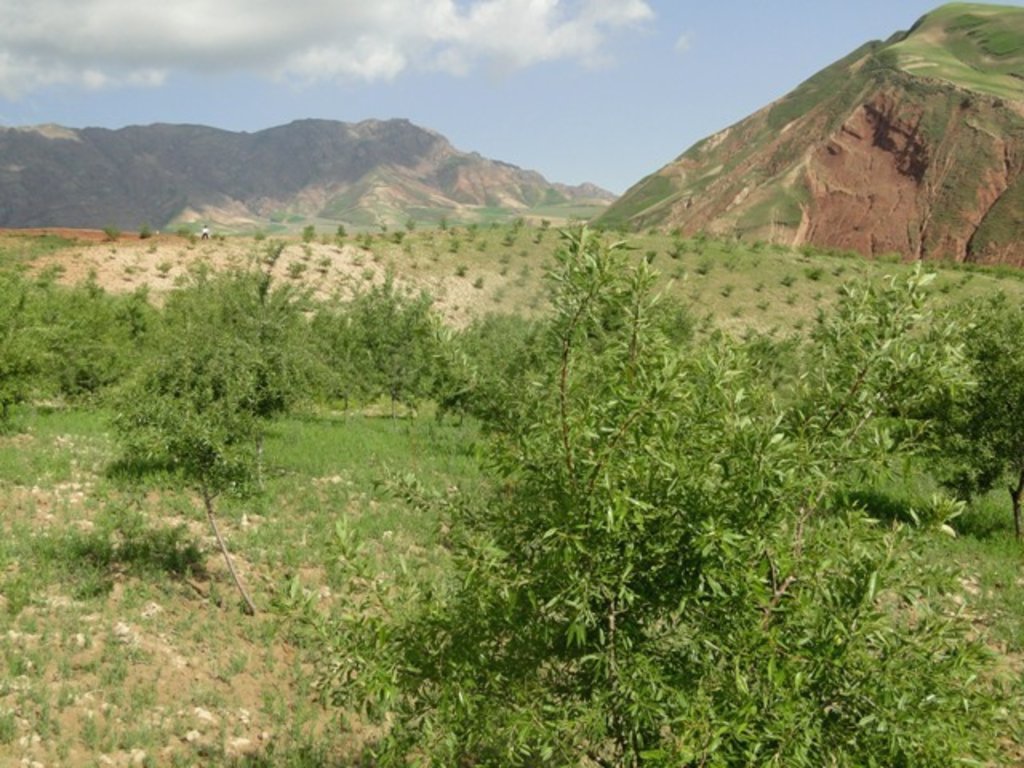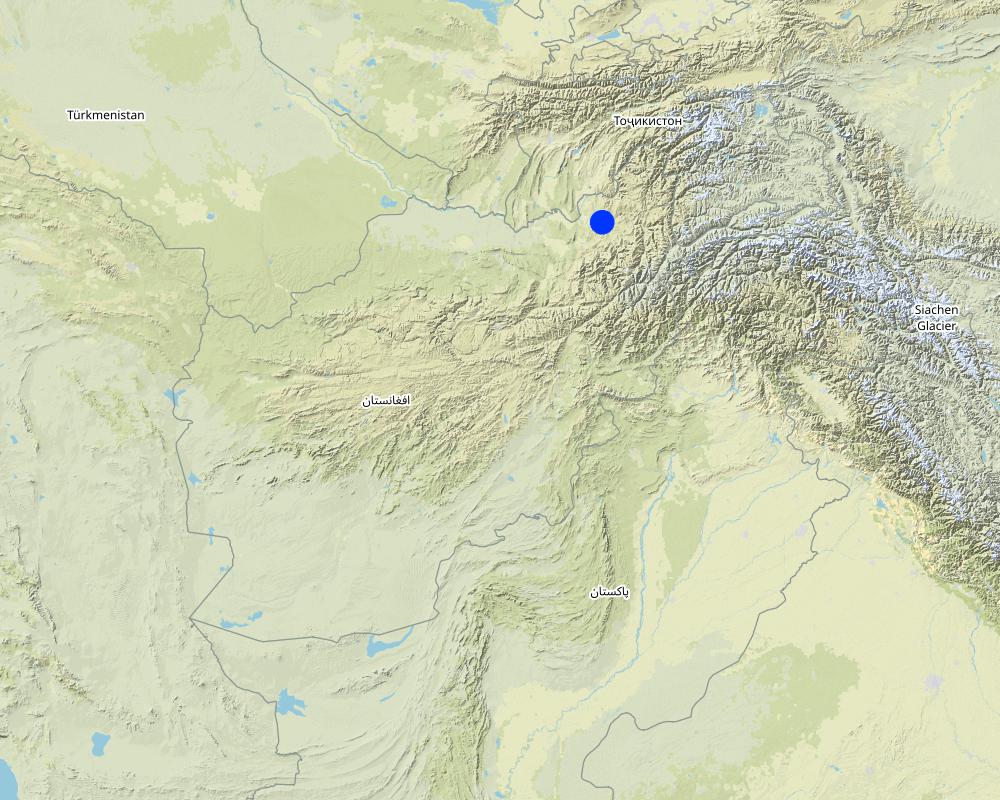Afforestation for firewood production [Афганистан]
- Шинийг нээх:
- Шинэчлэх:
- Эмхэтгэгч: Bettina Wolfgramm
- Хянан тохиолдуулагчид: MIAJAN MAROOFI, Hekmatullah Sharifzai, Roziya Kirgizbekova, Aslam Qadamov, Aqila Haidery
- Хянагч: William Critchley
Bunyodi jangal baroi tavlidi chubi sukht
technologies_668 - Афганистан
Бүлгүүдийг үзэх
Бүгдийг дэлгэх Бүгдийг хаах1. Ерөнхий мэдээлэл
1.2 Технологийг үнэлэх, баримтжуулах ажилд хамаарах мэдээлэл өгсөн хүмүүс, байгууллагуудын холбоо барих мэдээлэл
Мэдээлэл өгсөн хүн (с)
Газар ашиглагч:
Mohammad Azim Habibullah
Natural Resources Management Comittee (NRMC)
Sari Joy Village, Rustaq District
Афганистан
ГТМ мэргэжилтэн:
ГТМ мэргэжилтэн:
Researcher:
Технологи баримтжуулах/үнэлэх ажилд дэмжлэг үзүүлсэн төслийн нэр (шаардлагатай бол)
Potential and limitations for improved natural resource management (NRM) in mountain communities in the Rustaq district, Afghanistan (Rustaq NRM Study)Технологи баримтжуулах/үнэлэх ажилд дэмжлэг үзүүлсэн төслийн нэр (шаардлагатай бол)
Livelihood Improvement Project Takhar, Afghanistan (LIPT)Технологи баримтжуулах/үнэлэх ажилд дэмжлэг үзүүлсэн байгууллага(ууд)-ын нэр (шаардлагатай бол)
Terre des Hommes (Terre des Hommes) - ШвейцарТехнологи баримтжуулах/үнэлэх ажилд дэмжлэг үзүүлсэн байгууллага(ууд)-ын нэр (шаардлагатай бол)
Swiss Agency for Development and Cooperation (DEZA / COSUDE / DDC / SDC) - ШвейцарТехнологи баримтжуулах/үнэлэх ажилд дэмжлэг үзүүлсэн байгууллага(ууд)-ын нэр (шаардлагатай бол)
CDE Centre for Development and Environment (CDE Centre for Development and Environment) - ШвейцарТехнологи баримтжуулах/үнэлэх ажилд дэмжлэг үзүүлсэн байгууллага(ууд)-ын нэр (шаардлагатай бол)
Bern University of Applied Sciences, School of Agricultural, Forest and Food Sciences (HAFL) - Швейцар1.3 ВОКАТ-аар баримтжуулсан өгөгдлийг ашиглахтай холбоотой нөхцөл
Мэдээллийг хэзээ (газар дээр нь) цуглуулсан бэ?
27/10/2016
Эмхэтгэгч болон гол мэдээлэгч хүн(хүмүүс) WOCAT аргачлалаар баримтжуулсан мэдээллийг ашиглахтай холбоотой нөхцлийг хүлээн зөвшөөрсөн:
Тийм
1.4 Технологи тогтвортой гэдгийг баталгаажуулах
Энэ технологийг газрын доройтлыг бууруулж, газрын тогтвортой менежментийг хангахад тохиромжтой гэж үзэж болох уу?
Үгүй
Тайлбар:
SLM practices documented in the frame of the Rustaq NRM study were established only recently (1-3 years ago). It is too early for a final judgment on the sustainability of these technologies within the human and natural environment of Chokar watershed.
2. ГТМ Технологийн тодорхойлолт
2.1 Технологийн товч тодорхойлолт
Технологийн тодорхойлолт:
Non-fruit and fruit trees are planted on heavily degraded forest land to protect the land from erosion and further degradation and provide fuelwood for the local community.
2.2 Технологийн дэлгэрэнгүй тодорхойлолт
Тодорхойлолт:
Project supported implementation of afforestation has taken place in the villages of Sari Joy, Jawaz Khana and Dashti Mirzai, located in Chokar watershed of Rustaq District in Northern Afghanistan. The Chokar watershed is a mountainous area situated between 600 and 2,500 m above sea level. The climate is semi-arid with harsh and cold weather in winter, and hot and dry summers. The annual precipitation in average years is 580 mm. Land degradation affects all forms of land use, and includes low levels of vegetation cover, severe water erosion of topsoil, and poor soil fertility. Unsustainable agricultural practices, over-exploitation and high pressure on the natural resources are adversely impacting the socio-economic well-being of local communities, as well as contributing to the risk of being adversely affected by drought - and landslides and flash foods triggered by heavy rainfall. The data used for the documentation of the technology are based on field research conducted in Chokar watershed, namely in the villages of Sari Joy, Jawaz Khana and Dashti Mirzai. These villages represent the upper, the middle and the lower zones of Chokar watershed, respectively. They differ considerably in access to services and infrastructure, but in general are poorly served. The communities depend on land resources for sustaining their livelihoods. In a good year with high yields, wheat self-sufficiency lasts about 5 months. The three villages are home to ethnic Qarluq communities. Since 2012 the Livelihood Improvement Project Takhar (LIPT) implemented by Terre des hommes (Tdh) Switzerland has initiated a range of NRM interventions
Despite the low forest cover in Rustaq, Afghanistan, local communities strongly rely on fuelwood and animal dung for cooking and heating throughout the whole year. Forests are mainly found on community land with open access to all, and there are no protection measures in place. The high demand on fuelwood for household needs places strong pressure on the remaining patches of forests and bushes, which are currently threatened by eradication. Such high demand in the area is likely to remain as there are no other alternative energy sources. The mass destruction of local forests is one of the main causes of intensive erosion, aridification, loss of topsoil and formation of gullies. Low forest cover increases vulnerability to severe rainfall and risks of landslides.
Afforestation measures in the three villages were initiated to halt the land degradation and provide sustainable firewood. The reforestation sites are largely on community land with a small share on private land. The area is characterized by hilly (16-30%) and steep (31-60%) slopes. Planting and maintaining forest in such conditions requires close support in the appropriate design of forest plots, and relevant maintenance recommendations, which can then ensure the survival of the plantation. A plot of 0.2 ha is divided into 4 m x 3 m sections. Each tree is placed in a pit of 50 cm x 30 cm with rich soil around the roots. Once the tree is planted, it is watered and covered with lime. Russian willow, acacia, mulberry and almond are the most common tree species used for afforestation purposes.
Most of the newly established forest sites are located at walking distance of the nearby villages: this is important to help provide protection of the plot from animal intrusion and ensure proper maintenance of the trees. The forest plot is watered for three years in a row. The Natural Resources Management Committees (NRMC) pays 0.60 US cents per tree per year to sustain the survival of the plantation within the first year. The funding for the irrigation is provided by the Livelihood Improvement Project Takhar (LIPT). LIPT supported the afforestation activities through the provision of technical and financial support. The tree seedlings were supplied by the project, and financial incentives were provided to engage the community in tree-planting.
The plantations are still very young: however, the land users express support for the new forest in their villages, and have observed localized stabilization of the soil and improvement in vegetation cover. There are high expectations of the new forest, which promises access to sustainable fuelwood and non-forest products, such as almonds and mulberry. The grass and tree leaves from the forest plots are already used for animal fodder.
Women and children under 15 years old are expected to be the direct beneficiaries of the new forest. They will no longer spend long hours to collect and deliver fuelwood, bushes and dung. A small portion of women reported involvement in forest establishment activities, while the majority are taking part in protecting the forests from livestock.
2.3 Технологийн гэрэл зураг
2.5 Энэ үнэлгээнд хамрагдсан технологийг хэрэгжүүлсэн улс орон/ бүс нутаг/ байршил
Улс:
Афганистан
Улс/аймаг/сум:
Takhar Province, Rustaq District
Байршлын дэлгэрэнгүй тодорхойлолт:
Sari Joy, Jawaz Khana, Dashti Mirzai
Тайлбар:
This documentation is based on the experiences of SLM impementers from Sari Joy (5 plots), Jawaz Khana, (4 plots), and Dashti Mirzai (3 plots) as compiled during focus group discussions. Additionally insights were gained through interviews in all three villages on farmers experiences and observations of afforestation plots, with both SLM implementers (20) and observers (10).
Map
×2.6 Хэрэгжсэн хугацаа
Байгуулсан тодорхой оныг мэдэхгүй бол баримжаа хугацааг тодорхойл:
- <10 жилийн өмнө (саяхны)
2.7 Технологийн танилцуулга
Технологийг хэрхэн нэвтрүүлснийг тодорхойл:
- Гадны төсөл/хөтөлбөрийн дэмжлэгтэйгээр
Тайлбар (төслийн төрөл г.м.):
Livelihood Improvement Project Takhar (LIPT) supported by Swiss Development Cooperation (SDC) from 2012-17
3. ГТМ технологийн ангилал
3.1 Технологийн үндсэн зорилго (ууд)
- үйлдвэрлэлийг сайжруулах
- газрын доройтлыг бууруулах, сэргийлэх, нөхөн сэргээх
- гамшгийн эрсдлийг бууруулах
3.2 Технологи нэвтрүүлсэн газрын одоогийн газар ашиглалтын хэлбэр(үүд)
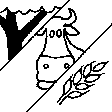
Холимог (тариалан/бэлчээр/мод), үүнд. ХАА-н ойжуулалт
- Ой-мал аж ахуйн систем
Гол бүтээгдэхүүн/ үйлчилгээ:
Acacia, Russian willow, mulberry. almond, grass and leaves for fodder
Хэрэв технологи нэвтрүүлснээр газар ашиглалтад өөрчлөлт гарсан бол технологи нэвтрүүлэхээс өмнө байсан газар ашиглалтын хэлбэрийг тодорхойлно уу:
Some of the forest land has been heavily degraded and was used as grazing land for an extensive period. Most of the land is forest land.
3.3 Газар ашиглалтын тухай нэмэлт мэдээлэл
Технологи хэрэгжүүлсэн газрын усан хангамж:
- Байгалийн/усалгаатай арга хосолсон
Тайлбар:
During the first three years the forest requires irrigation due to aridity. The first year of irrigation is supported by the project, and the rest of the irrigation measures are implemented by the local community with the support of the NRMC.
Жилд ургамал ургах улирлын тоо:
- 1
3.4 Технологи ГТМ-ийн аль бүлэгт хамаарах вэ
- хөрс/ ургамлын бүрхэвч сайжруулах
3.5 Технологийн хамрах талбай
Технологи өргөн дэлгэрсэн эсхийг тодорхойл:
- газар дээр жигд тархсан
Технологи газар нутгийн хэмжээнд жигд тархсан бол түүний эзлэх талбайг дундажаар тооцож тэмдэглэ:
- 0.1-1 км2
Тайлбар:
23.6 ha
3.6 Технологийг бүрдүүлэх ГТМ арга хэмжээ

Ургамлын арга хэмжээ
- V1: Мод ба бут, сөөг
- V2: Өвс ба олон наст өвслөг ургамал
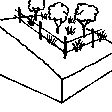
Менежментийн арга хэмжээ
- М1: Газар ашиглалтын хэлбэрийг өөрчлөх
3.7 Технологид харгалзах газрын доройтлын төрөл

хөрс усаар эвдрэх
- Wt: Хөрсний гадаргын угаагдал
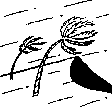
хөрс салхиар эвдрэх
- Et: Хөрсний гадаргын зөөгдөл

биологийн доройтол
- Bc: Ургамлан нөмрөг багасах
- Bq: биомасс буурах
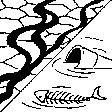
усны доройтол
- Ha: Хуурайшилт
3.8 Газрын доройтлоос урьдчилан сэргийлэх, сааруулах ба нөхөн сэргээх
Газрын доройтолтой холбоотойгоор Технологи ямар зорилго тавьсан болохыг тодорхойл:
- Газрын доройтлыг бууруулах
- Хүчтэй доройтсон газрыг нөхөн сэргээх/ сайжруулах
4. Техникийн нөхцөл, хэрэгжүүлсэн үйл ажиллагаа, материал ба зардал
4.1 Технологийн техник зураг
Зохиогч:
Aslam Qadamov; Roziya Kirgizbekova
Он, сар, өдөр:
03/04/2017
4.2 Техникийн үзүүлэлт/ техникийн зургийн тайлбар
The establishment activities begin with selecting the area for reforestation. Most of the reforestation sites are on slopes above 6% steepness . A plot of 0.2 ha is divided into 4 m x 3 m sections. Planting pits of 50 cm x 30 cm are prepared for planting the trees. Each tree is placed in a pit and good soil is added to the roots. Most popular species used for reforestation are: Russian willow, acacia and mulberry. The newly planted tree is watered and the trunk is covered with a lime and water solution for protection and better growth.
4.3 Материал болон зардалд хамаарах ерөнхий мэдээлэл
Үнэ өртөг, оруулсан хувь нэмрийг хэрхэн тооцсоныг тодорхойл:
- Технологийн нэгж тус бүр
Талбайн хэмжээ ба нэгжийг тодорхойл:
1 ha
Үнэ өртөгийг тооцоход ашигласан мөнгөн нэгж:
- Америк доллар
Ам.доллар ба үндэсний мөнгөн нэгж хоорондын хөрвөх үнийг тодорхойл (шаардлагатай бол): 1 USD =:
67.0
Хөлсний ажилчны нэг өдрийн цалингийн хэмжээг тодорхойлно уу:
5.2-5.3 USD
4.4 Бий болгох үйл ажиллагаа
| Үйл ажиллагаа | Арга хэмжээний төрөл | Хугацаа | |
|---|---|---|---|
| 1. | Design of the forest plot | Менежментийн | Winter |
| 2. | Digging pits 50 cmx 30 cm for tree plantation | Барилга байгууламжийн | End of winter |
| 3. | Planting tree seedlings 3m x 4m | Ургамлын | Spring/Rainy season |
| 4. | Watering the tree after planting | Ургамлын | Spring |
| 5. | Covering the tree with lime | Бусад арга хэмжээ | Spring |
4.5 Бий болгоход шаардагдсан зардал, хөрөнгийн өртөг
| Зардлын нэр, төрөл | Хэмжих нэгж | Тоо хэмжээ | Нэгжийн үнэ | Зардал бүрийн нийт өртөг | Нийт дүнгээс газар ашиглагчийн төлсөн % | |
|---|---|---|---|---|---|---|
| Хөдөлмөр эрхлэлт | Design of the forest | person-day | 15.0 | 5.3 | 79.5 | |
| Хөдөлмөр эрхлэлт | Digging pits/holes for the trees | person-day | 22.0 | 5.3 | 116.6 | |
| Хөдөлмөр эрхлэлт | Planting tree seedlings and watering | person-day | 15.0 | 5.3 | 79.5 | |
| Хөдөлмөр эрхлэлт | Fertilizer and lime application | person-day | 8.0 | 5.3 | 42.4 | |
| Тоног төхөөрөмж | Meter | piece | 1.0 | 2.25 | 2.25 | |
| Тоног төхөөрөмж | Shovel | piece | 2.0 | 3.8 | 7.6 | |
| Тоног төхөөрөмж | Pickaxe | piece | 1.0 | 2.25 | 2.25 | |
| Тоног төхөөрөмж | Rope | meter | 500.0 | 0.07 | 35.0 | |
| таримал материал | Accacia seedlings | piece | 275.0 | 0.45 | 123.75 | |
| таримал материал | Russian willow seedlings | piece | 275.0 | 0.45 | 123.75 | |
| таримал материал | Mulberry seedlings | piece | 275.0 | 0.45 | 123.75 | |
| Бордоо ба биоцид | DAP | kg | 250.0 | 0.9 | 225.0 | |
| Бордоо ба биоцид | Lime | kg | 25.0 | 1.5 | 37.5 | |
| Технологи бий болгох нийт үнэ өртөг | 998.85 | |||||
Хэрэв газар ашиглагч нийт зардлын 100% -иас бага хэсгийг төлсөн бол хэн голлох зардлыг гаргасан бэ:
Livelihood Improvement Project Takhar (LIPT) implemented by Terre des hommes (Tdh) Switzerland
Тайлбар:
Costs calculated for a Technology area of 1ha was only done for the purpose of the WOCAT documentation. In reality SLM plots are on average 0.4 ha or 2 jiribs. Costs were simply multiplied by 2.5. The actual costs for a 1ha plot might be slightly different.
4.6 Арчилгаа/ урсгал үйл ажиллагаа
| Үйл ажиллагаа | Арга хэмжээний төрөл | Хугацаа/ давтамж | |
|---|---|---|---|
| 1. | Protecting the trees from livestock | Менежментийн | Spring/Summer |
| 2. | Pest and disease control | Ургамлын | Spring |
| 3. | Irrigation | Агрономийн | Summer/First three years |
| 4. | Replanting dead trees | Ургамлын | Spring |
| 5. | Pruning | Агрономийн | Spring |
4.7 Арчилгаа/урсгал ажилд шаардагдсан зардал, хөрөнгийн өртөг (нэг жилд)
| Зардлын нэр, төрөл | Хэмжих нэгж | Тоо хэмжээ | Нэгжийн үнэ | Зардал бүрийн нийт өртөг | Нийт дүнгээс газар ашиглагчийн төлсөн % | |
|---|---|---|---|---|---|---|
| Хөдөлмөр эрхлэлт | Pest and disease control | person day | 7.5 | 5.3 | 39.75 | 100.0 |
| Хөдөлмөр эрхлэлт | Replanting dead trees | person day | 7.5 | 5.3 | 39.75 | 100.0 |
| Хөдөлмөр эрхлэлт | Irrigating the trees | person day | 10.0 | 5.3 | 53.0 | 100.0 |
| Хөдөлмөр эрхлэлт | Pruning | person day | 5.0 | 5.3 | 26.5 | 100.0 |
| Технологийн арчилгаа/урсгал үйл ажиллагаанд шаардагдах нийт үнэ өртөг | 159.0 | |||||
Тайлбар:
Costs calculated for a Technology area of 1ha was only done for the purpose of the WOCAT documentation. In reality SLM plots are on average 0.4 ha or 2 jiribs. Costs were simply multiplied by 2.5. The actual costs for a 1ha plot might be slightly different.
4.8 Зардалд нөлөөлж байгаа хамгийн чухал хүчин зүйл
Өртөг, зардалд нөлөөлөх гол хүчин зүйл:
Due to the remoteness of the villages where the technology has been implemented, all the inputs for establishment, such as agricultural equipment, plant material, fertilizers, etc., are purchased in Rustaq town. The expenses for traveling and delivering the inputs affect the establishment costs.
5. Байгаль ба нийгмийн нөхцөл
5.1 Уур амьсгал
Жилийн нийлбэр хур тундас
- < 250 мм
- 251-500 мм
- 501-750 мм
- 751-1,000 мм
- 1,001-1,500 мм
- 1,501-2,000 мм
- 2,001-3,000 мм
- 3,001-4,000 мм
- > 4,000 мм
Жилийн дундаж хур тунадас (хэрэв мэдэгдэж байвал), мм:
564.00
Хур тунадасны талаархи тодорхойлолт/ тайлбар:
Average annual precipitation for the area was calculated with 564 mm, with minimum in dry years (2000 and 2001) of 270 mm and maximum in wet years (2009/2010) of 830 mm. The absolute maximum rainfall was calculated for 1986 with 1024 mm. The data series covers the time from 1979 to 2014.
Холбогдох цаг уурын станцын нэр:
Climate Forecast System Reanalysis (CFSR), http://rda.ucar.edu/pub/cfsr.html
Агро-уур амьсгалын бүс
- хагас хуурай
Derived from the publicly available dataset on length of growing period (LGP) (Fischer 2009 / IIASA-FAO). Internet link: http://tiles.arcgis.com/tiles/P8Cok4qAP1sTVE59/arcgis/rest/services/Length_of_growing_period/MapServer
5.2 Гадаргын хэлбэр
Дундаж налуу:
- хавтгай (0-2 %)
- бага зэрэг налуу (3-5 %)
- дунд зэрэг налуу (6-10 % )
- хэвгий (11-15 %)
- налуу (16-30 %)
- их налуу (31-60 % )
- эгц налуу (>60 %)
Гадаргын хэлбэр:
- тэгш өндөрлөг / тал
- нуруу
- уулын энгэр
- дов толгод
- бэл
- хөндий
Өндрийн бүслүүр:
- 0-100 д.т.д. м.
- 101-500 д.т.д. м.
- 501-1,000 д.т.д м.
- 1,001-1,500 д.т.д м.
- 1,501-2,000 д.т.д м.
- 2,001-2,500 д.т.д. м.
- 2,501-3,000 д.т.д. м.
- 3,001-4,000 д.т.д м.
- > 4,000 д.т.д. м.
5.3 Хөрс
Хөрсний дундаж зузаан:
- маш нимгэн (0-20 см)
- нимгэн (21-50 см)
- дунд зэрэг зузаан (51-80 см)
- зузаан (81-120 cм)
- маш зузаан (>120 cм)
Хөрсний бүтэц (өнгөн хөрс):
- дундаж (элсэнцэр, шавранцар)
Хөрсний бүтэц (>20 см-ээс доош):
- дундаж (элсэнцэр, шавранцар)
Өнгөн хөрсөнд агуулагдах ялзмаг:
- дунд (1-3 % )
- бага (<1 % )
Боломжтой бол хөрсний бүрэн тодорхойлолт, боломжит мэдээллийг өгнө үү, жишээ нь хөрсний төрөл, хөрсний урвалын орчин/хүчиллэг байдал, катион солилцох чадавхи, азотын хэмжээ, давсжилт г.м.
Local land users refer to the soil type where reforestation is implemented as:
Dark soil is characterized as: moderately deep; topsoil texture medium, below surface texture medium; and medium topsoil organic matter.
Light soil is characterized as: moderately deep; texture medium; medium, low organic matter.
5.4 Усны хүртээмж ба чанар
Гүний усны түвшин:
5-50 м
Гадаргын усны хүртээмж:
дунд зэрэг
Усны чанар (цэвэршүүлээгүй):
сайн чанарын ундны ус
Усны давсжилтын асуудал бий юу?
Үгүй
Энэ газар үерт автдаг уу?
Тийм
Тогтмол байдал:
тохиолдлын
Усны чанар, нөөцийн талаархи тайлбар ба бусад тодорхойлолт:
Floods occur mainly during the rainy seasons in spring and autumn. Availability of surface water varies in the three study villages. Sari Joy and Dashti Mirzai have good surface water availability, which is also food for drinking. Jawaz Khana has poor water both in quality and availability. Water has to be fetched from a distant stream.
5.5 Биологийн олон янз байдал
Зүйлийн олон янз байдал:
- Бага
Амьдрах орчны олон янз байдал:
- Бага
5.6 Технологи нэвтрүүлсэн газар ашиглагчдын тухай мэдээлэл
Суурьшмал эсвэл нүүдлийн:
- Суурьшмал
Үйлдвэрлэлийн системийн зах зээлийн чиг баримжаа:
- амь зуух арга хэлбэрийн (өөрийгөө хангах)
- холимог (амь зуух/ худалдаа наймаа
Бусад эх үүсвэрээс олох орлого:
- Нийт орлогын 10-50 %
- Нийт орлогын 50 %-иас дээш
Чинээлэг байдлын түвшин:
- дундаж
- чинээлэг
Хувь хүн эсвэл бүлэг:
- Хувь хүн / өрх
- бүлэг / олон нийтийн
Механикжилтын түвшин:
- гар ажил
Хүйс:
- эмэгтэй
- эрэгтэй
Газар ашиглагчийн нас:
- дунд нас
- ахимаг нас
Газар ашиглагчдын бусад шинж чанарыг тодорхойл:
The land users in the area where the Technology is applied belong to the Uzbek ethnic minority group Qarluq. Although the men are generally the main land users, women and children also take active part in the related work. The functions of men and women are clearly distinguished within the Afghan society. At the same time within the family this division of work and functions also results in men and women working hand-in-hand. An improvement of the family’s livelihood situation is expected to positively affect all family members. While it is recognized that the involvement of women is key in order to secure basic human rights for everyone, to achieve good governance, sustainable development, and to efficiently contribute to poverty reduction (SDC 2004), it is also clear that a context sensitive approach is of high importance.
Women in rural Afghanistan are involved in many production and income generating activities that contribute to the overall household income, however very few women own resources such as land and livestock, and their income generating options are fewer in comparison to that of men.
5.7 Технологи нэвтрүүлсэн газар ашиглагчийн өмчилж буй, эзэмшиж буй, түрээсэлж буй эсвэл ашиглаж буй (ашиглах эрх) газрын талбай
- < 0.5 га
- 0.5-1 га
- 1-2 га
- 2-5 га
- 5-15 га
- 15-50 га
- 50-100 га
- 100-500 га
- 500-1,000 га
- 1,000-10,000 га
- > 10,000 га
Энэ талбай том, жижиг, дунд алинд хамаарах вэ (орон нутгийн нөхцөлд харгалзуулна уу)?
- дунд-хэмжээний
5.8 Газар эзэмшил, газар ашиглах эрх, ус ашиглах эрх
Газар өмчлөл:
- нэгдлийн/ тосгон
- хувь хүн, өмчийн гэрчилгээгүй
Газар ашиглах эрх:
- нэгдлийн хэлбэрээр (зохион байгуулалттай)
- хувь хүн
Ус ашиглах эрх:
- нэгдлийн хэлбэрээр (зохион байгуулалттай)
Тайлбар:
Those who own land and use water for irrigation are obliged to pay for water. The payment is made either in kind or in cash to Mirob - the person in charge of distributing water in the community. The amount of the payment varies from village to village.
6. Үр нөлөө ба дүгнэлт
6.1 Технологийн талбайд үзүүлсэн нөлөө
Нийгэм-эдийн засгийн үр нөлөө
Үйлдвэрлэл
тэжээл үйлдвэрлэл
малын бүтээмж
модлогийн бүтээмж
ойн дагалт баялгийн бүтээмж
бүтээгдэхүүний олон янз хэлбэр
Нийгэм-соёлын үр нөлөө
ГТМ/ газрын доройтлын мэдлэг
Тайлбар/ тодорхой дурьдах:
Land users learned new methods of planting trees based on the local conditions.
нийгэм, эдийн засгийн хувьд эмзэг бүлгийнхний нөхцөл байдал
Тайлбар/ тодорхой дурьдах:
The established forest is expected to become a reliable source for firewood, which will decrease the burden of women and children under 15 years, who spend long hours to collect firewood.
Экологийн үр нөлөө
Усны эргэлт/ илүүдэл
гадаргын урсац
Хөрс
хөрс алдагдах
Биологийн олон янз байдал: ургамал, амьтан
Ургамалын бүрхэвч
6.2 Технологийн талбайн гадна үзүүлсэн үр нөлөө
голын адагт үерлэх
голын адагт лаг шавар хуримтлагдах
буферлэх / шүүлтүүрийн багтаамж
Нөлөөллийн үнэлгээнд хамаарах нэмэлт тайлбар:
Based on the Land User Protocols: Individual SLM implementers were asked to rate the benefits for their Technology. They were asked to indicate production increase of crops; fodder; animals; wood; non-wood forest products; increase in product diversity; or production area. The most important increase they rated with 3, the second most with 2, others with 1 point. Averages of the points given by all SLM implementers are reflected here.
Based on the Land User Protocols: Individual SLM implementers were asked to rate the on-site and off-site impacts of the Technology on water; soil; and vegetation. They were asked to indicate the strength of impacts with three, two or one points. Averages of the points given by all implementers are reflected here.
6.3 Технологийн уур амьсгалын өөрчлөлт, цаг агаарын гамшигт үзэгдэлд өртөх байдал ба эмзэг байдал (газар ашиглагчийн бодлоор)
Уур амьсгалаас хамаарах аюул (гамшиг)
Цаг уурын гамшигт үзэгдэл
| Технологи түүний нөлөөг хэрхэн бууруулж байна? | |
|---|---|
| орон нутгийн аадар бороо | маш сайн |
Уур амьсгалын гамшиг
| Технологи түүний нөлөөг хэрхэн бууруулж байна? | |
|---|---|
| ган гачиг | сайн |
Тайлбар:
Based on the multi-criteria matrix: SLM implementers were asked to jointly discuss and rate how much the SLM technology reduced the lands vulnerability to drought and local rainstorms. Only vulnerability to the most prevalent climate extremes (drought and local rainstorms) was discussed. SLM technologies were rated as reducing vulnerability poorly, well, or very well. The average points reflected here are from multi-criteria matrixes compiled in three villages where the SLM technology had been implemented
6.4 Өртөг ба ашгийн шинжилгээ
Бий болгох зардалтай харьцуулахад ямар ашиг өгсөн бэ (газар ашиглагчийн бодлоор)?
Богино хугацаанд эргэн төлөгдөх байдал:
маш эерэг
Урт хугацаанд эргэн төлөгдөх байдал:
маш эерэг
Тайлбар:
Based on the multi-criteria matrix: During the FGD with SLM implementers, a multi-criteria matrix was elaborated, and different SLM practices were rated. In the framework of this exercise, SLM implementers were asked to jointly discuss and rate short term (1-3 years) and long-term (10 years) returns. As the SLM technology was only implemented 1-2 years ago, it is too early to compare benefits to maintenance costs. Farmers have little experience so far on the actual benefits of the SLM technology. The ratings are mostly based on expected benefits and not on actual benefits.
6.5 Технологи нэвтрүүлэлт
- 1-10 %
Боломжтой бол, тоогоор илэрхийл (өрхийн тоо эсвэл бүрхэх талбай):
23.6 ha have been afforested with LIPT support
Технологи нэвтрүүлсэн хүмүүсээс хэд нь өөрийн хүчээр технологийг хэрэгжүүлсэн бэ, өөрөөр хэлбэл гадны тусламж дэмжлэг авалгүйгээр?
- 10-50%
Тайлбар:
Based on the Land User Protocol: Individual SLM implementers were asked whether they received support for implementing the Technology. Each indicated the type of support he received from the proposed options: "Full Support 100%, Some Support, No Support 0%".
6.6 Дасан зохицох
Бий болсон өөрчлөлтөд зохицуулан технологийг өөрчилсөн үү?
Үгүй
6.7 Технологийн давуу тал/боломжууд
| Газар ашиглагчдын тодорхойлсон давуу тал/боломжууд |
|---|
| The tree plantations protect the soil from erosion. The land is less vulnerable to heavy rainfall, which washes off the topsoil |
| There are very high expectations about production of firewood. Availability of firewood in local forest will make it much easier to access firewood for cooking and heating by local households. |
| Apart from firewood and wood production, other non-timber products are provided by the afforestation plots, such as fodder for livestock from grass (alfalfa, sainfoin) and tree leaves during autumn. Also some plots are planted with almond and mulberry, which can be collected for own use or for selling. |
| Local people value the recreational benefit of the forest, which make their villages greener and provide green spaces for the local people. |
| Эмхэтгэгч, бусад мэдээлэл өгсөн хүмүүсийн өнцгөөс тодорхойлсон давуу тал/боломжууд |
|---|
| The afforestation measures in the village including establishing the forest and protecting it, mobilizing the community around a common goal, and this has a positive impact on the village as a whole. |
| The planted trees and grass under the trees improve the vegetation cover and increase soil quality, which is then less prone to erosion |
| Improved varieties of fruit and non-fruit tree species used for afforestation help to diversify the tree species in the village and make the soil less resistant to dry spells |
| The expected combined benefits of wood and non-wood products, especially when the harvesting period starts, may have positive impact on households' income and food security. |
6.8 Технологийн дутагдалтай/сул тал/аюул болон тэдгээрийг хэрхэн даван туулах арга зам
| Газар ашиглагч нарын тодорхойлсон сул тал/ дутагдал/ эрсдэл | Тэдгээрийг хэрхэн даван туулах вэ? |
|---|---|
| The establishment costs for afforestation measures are very high | |
| The young trees are vulnerability to droughts | |
| During maintenance some plots require irrigation | |
| Afforestation plots, which are established on former grazing land, reduces the grazing land in the village and deprives animals from grazing land |
| Эмхэтгэгч, бусад мэдээлэл өгсөн хүмүүсийн өнцгөөс тодорхойлсон сул тал/ дутагдал/ эрсдэл | Тэдгээрийг хэрхэн даван туулах вэ? |
|---|---|
| Community provides weak or no protection of the afforestation site, which results in low tree survival | |
| Weak funding sources for irrigation of the afforestation plots, particularly during the first three years when the trees are young, might compromise the new plantations | |
| Afforestation is established mostly on community land, where unclear land tenure rights persist, which may cause conflict in the community over forest vs grazing land |
7. Ном зүй ба холбоосууд
7.1 Мэдээлэл цуглуулсан арга/эх үүсвэр
- Хээрийн уулзалт, судалгаа
No field visits were conducted
- Газар ашиглагчтай хийсэн ярилцлага
Focus group discussions (FGD) were organized by the CDE team to collect information from SLM implementers. Total of 15 land users who have implemented afforestation, participated in the FGDs held in the three villages of Sari Joy, Jawaz Khana and Dashti Mirzai.
Interviews were conducted by the HAFL team to collect information from persons representing all the three study villages. Very detailed interviews were conducted with 30 persons interested in afforestation implementation, of which 20 persons are from households that already have implemented afforestation.
- ГТМ-ийн мэргэжилтэн/шинжээчтэй хийсэн ярилцлага
Close collaboration took place during the compilation of this material with the technical staff of the LIPT project in Rustaq.
- тайлан болон бусад эх сурвалжийн бүрдэл
Information provided in the reports of the LIPT project in Rustaq served as an initial source of information during the preparatory phase and also solidifying the description of the technology and area of implementation. Other background papers on Afghanistan were referred to for general information on agriculture and natural resource management in Afghanistan.
7.2 Ном, хэвлэлийн ишлэл
Гарчиг, зохиогч, он, ISBN:
Guidelines for Focus Groups Discussions
Гарчиг, зохиогч, он, ISBN:
Methods section of the Rustaq NRM study
Холбоос ба модулууд
Бүгдийг дэлгэх Бүгдийг хаахХолбоосууд
Холбоос байхгүй байна
Модулууд
Модуль байхгүй байна


